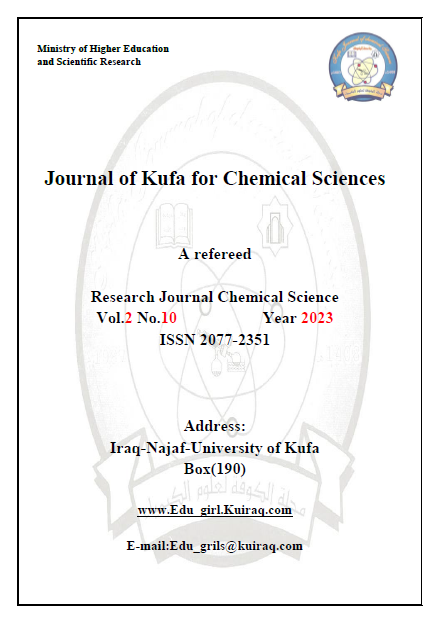Synthesis and characterization of α-Fe2O3 Nanoparticles and α-Fe2O3 /TiO2 Nanocomposite and application them in a solar cell
DOI:
https://doi.org/10.36329/jkcm/2023/v2.i10.10699Keywords:
Keywords: Nanocomposite, Hydrothermal, DSSCs.Abstract
Abstract:
Nanostructures of metal oxides of TiO2 and α-Fe2O3 are prepared through the hydrothermal method. Also α-Fe2O3/TiO2nanocomposites are prepared by the hydrothermal technique using an and α-Fe2O3 /TiO2 nanocomposites are mixed in the equal ratio. The properties of the prepared compounds are investigated through Field Emission Scanning Electron Microscopy (FE-SEM), Transmission Electron Microscopy (TEM), X-Ray Diffraction (XRD). The optical properties of prepared compounds are studied through UV-Vis Spectroscopy, X-ray diffraction patterns of prepared TiO2, and α-Fe2O3 have shown a( monoclinic structure, Tetragonal, and Hexagonal ) respectively. The optical band gap is (3.0, 1.6 and 2.7) eV for TiO2, α-Fe2O3 NPs and CuO/TiO2/α-Fe2O3nanocomposites. Dye-sensitized solar cells (DSSCs) fabricated based on TiO2, α-Fe2O3 NPs and α-Fe2O3 /TiO2/ nanocomposites are casted onto (FTO) substrates (front electrode). while the back electrode is a carbon/FTO-glass substrate. Two natural dyes of dyes are used green leek dye and red pomegranate dye whereas iodine/ iodide (KI/I2) is used as the electrolyte solution.. The solar cells efficiency rates (0.65, 1.38 and 0.96) for TiO2, α-Fe2O3 Nps and α-Fe2O3 /TiO2/ nanocomposites/re d pomegranate dye respectively. and The solar cells' efficiency rates are (0.69, 1.93 and1.29) for TiO2, and α-Fe2O3 /TiO2/ nanocomposites/ green leek dye respectively
Downloads
Downloads
Published
How to Cite
Issue
Section
License
Copyright (c) 2023 Journal of Kufa for Chemical Sciences

This work is licensed under a Creative Commons Attribution 4.0 International License.
Open-access Statement
The journal « Journal Of Kufa For Chemical Sciences» provides immediate open access to its content on the principle that making research freely available to the public supports a greater global exchange of knowledge. Full-text access to scientific articles of the journal is presented on the official website in the Archives section.
This is in accordance with the BOAI definition of open access. The licensing policy is compatible with the overwhelming majority of open access and archiving policies.
The journal «Journal Of Kufa For Chemical Sciences» is an open access journal, which means all its content is freely available without charge to the user or his/her institution. Users are allowed to read, download, copy, distribute, print, search, or link to the full texts of the articles, or use them for any other lawful purpose, without asking prior permission from the publisher or the author as long as they cite the source.The journal is licensed by Creative Commons Attribution International( CC Attribution 4.0) .


